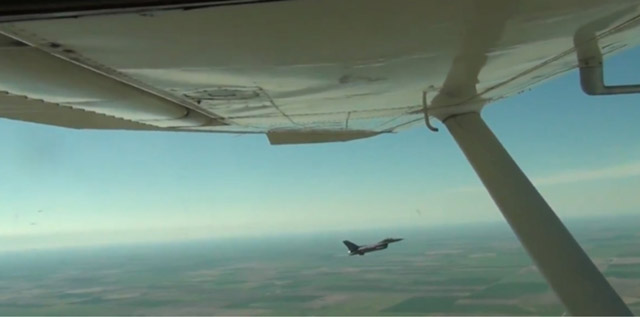Tips for GA operators in the national airpace

AOPA's fly-ins offer a great opportunity to learn about a variety of topics from expert presenters. The North American Aerospace Defense Command (NORAD) is featured at many of the events, presenting on the importance of properly navigating in and around temporary flight restrictions (TFRs).
What is a TFR?
There are many types of TFRs. A common type is a sceurity/VIP TFR that protects a high value asset on the ground, such as the president of the United States or United Nations leaders, and highly visible events such as a political convention or the Super Bowl. Once the FAA establishes a TFR, it is responsible for enforcing the restrictions, and NORAD fighter aircraft are responsible for defending it.
To find the latest information on active TFRs, pilots should call flight service (800-WX-BRIEF) prior to flight.
A presidential TFR typically consists of a 10-nm inner ring and a 30-nm outer ring from the location, and from the ground up to and including 17,999 feet msl. Most general aviation aircraft are not allowed to fly in the inner ring, so it is often customized to reduce the inconvenience for local airports. GA aircraft are often allowed to fly through the outer ring, as long as they follow a few basic procedures, including talking to ATC, squawking a discrete code, and operating on an active flight plan. Unfortunately, the majority of TFR violations are because of a lack of proper preflight planning. If you plan to avoid a TFR entirely, a good rule of thumb is to give yourself a three- to five-mile buffer because an alleged violation is based on the FAA radar overlay of the TFR, not your GPS track.
There's an F–16 off my wing, no what?
If you violate a TFR, you will likely be intercepted by a NORAD fighter that will observe your cockpit and identify your aircraft type and tail number. The fighter will then guide you out of the TFR.
Monitoring VHF Guard (121.5 MHz) during your flight will allow you to receive communications from the FAA and NORAD air defense ground operators and fighters; you may hear a call on VHF Guard that identifies an aircraft at your position with direction to avoid or exit the restricted airspace.
Regardless of radio communication, if you violate the airspace, expect the fighter to pass on your left at approximately 500 feet lateral distance, rocking its wings. Seeing a fighter off your wing at any distance may be startling, so it is important to remain calm, acknowledge the fighter by rocking your wings, and continue flying your aircraft in a predictable manner. Continue your current altitude, airspeed, and heading (unless directed otherwise), and await instructions from the fighter, either on VHF Guard (if you are radio equipped) or via visual signals. The fighter pilots are there to escort you out of the airspace and are professionals trained to safely intercept general aviation aircraft without compromising flight safety.
Unpredictable movement of your aircraft or failure to depart a TFR expeditiously may result in you being deemed a “suspect” aircraft, necessitating additional action by the fighter, including flying across your nose at a safe distance and dispensing flares.
Keep in mind you may be directed to land at the first available airport instead of your planned destination.
For more information, check the Aeronautical Information Manual, Section 5-6-2.
Web: www.NORAD.mil/GeneralAviation
Things to remember
Prepare: Read and understand the notams. Use flight service as a reference.
Talk: If a TFR allows transit, in many cases a squawk code and ATC communication are required.
Move along: Do not loiter in or near TFR airspace. Give these areas a wide berth.


